‘DIYASADANA’- PROJECT OF MAKING DRINKING WATER FOR RURAL HABITATS
01. VISION: Water is the first prerequisite for any human habitats and the prime project vision is set to make easy access for contaminant free drinking water for the poverty stricken communities living in difficult rural areas.
02. MISSION:
1. Novel technologies for ‘Natural Water Purification’ are practiced to help rural communities in the Kidney Trouble affected areas in Sri Lanka.
2. Spreading of the successful technologies for application to overcome the same water problem in South Asia and African countries.
03. OBJECTIVE:
Research, Designing Infrastructures, Implementation,Monitoring and Evaluation of Innovative Technologiesto make easy access for contaminants free Drinking Water for poverty stricken isolated Rural Communities.
04. INNOVATIVE TECHNOLOGIES:
1. Percolation Well of Underground Filter Base (T-01):

FIGURE-01
Research:
Water from wells in the plain and mild sloppy semiarid zonal regions in Sri Lanka, is suspected to contain Fluoride and other Kidney effectible metals. As a proof more than 90% of Kidney patients use drinking water from deep wells constructed in reddish soil. People who use water from shallow wells near to village reservoir tanks, get almost no Kidney failures as recorded.
Reasoning:
Village tank beds are naturally well sealed by a hardly compacted mud layer. Therefore the water percolated in to nearing shallow wells could have been nicely filtered by the hard clay layer.
But in the upstream areas of the reservoirs, wells are deep penetrated in to Fluoride rich reddish soil.
Therefore it is reasonable enough to accept that, sustainability of the ancient Rajaratacascade reservoir based civilization,to exist nearly thousand years,caused upon the water security through natural water purification. Habitat settlements are always established downstream near to the tank bund and hence, the community had easy access for drinking water from shallow wells.
Problem Analysis:
The modern day problem is cropped up by the new human settlements in the upstream highland areas above the reservoir and people had to dig deep wells for water. Percolation through reddish soil brought Fluoride rich water for drinking.
Problem Solving Model:
Calcium is the best component to filter Fluoride. As a proof there is almost no Kidney trouble in the regions of where calcium rich soil is available. Therefore a special filter medium is designed for percolation wells which is rich with calcium and could be applied around the well at the stage of the construction as shown in the figure.
Advantageous effects:
1) Water filtration is an automatic function of the well
2) Materials for the filter are of locally easy availability
2. Percolation cum Rainwater Underground Haversing(T-02)

FIGURE-02
Research:
Yield of the Rainwater harvesting is adequate to manage throughout the year if the settlers living in the semiarid zonal regions. Renewability, Recoverability and Reusability are the prominent feature of the underground storing technique of rainwater because the used water is filtered and refreshed automatically.
Problem Analysis:
Prevailing technologies for rainwater harvesting in the background art are known for the problems such as filtration difficulties and mosquito breeding in the surface containers. Besides that no reusability and no recoverability of stored water within the system.
Problem solving Model:
About one-half of the settler land is landscaped so that a bit lowland funnel is created to collect the surface runoff and roof collection of rainwater. A funnel type filter bed is constructed with the sealed well under ground. Lateral water percolation is also allowed in to the well through a special vertical filter as shown in the figure.
Advantageous effects:
3) Mosquito breeding in the system is not possible at all
4) Water for bathing and washing is recycled automatically
5) Not only roof water but surface run off from the land is filtered and stored in the well
6) Bathing at the well provides natural aeration to keep water freshness in the well.
3. Natural Water Purification Plant (T-03)

FIGURE-03
Research:
People living in lowland marshy areas suffer from scarcity of Drinking Water because there is no technology to purify water from boggy water patches.
Water in such areas is contaminated with impurities and perhaps with toxic heavy metals due to agricultural residues flown in to the water bodies as surface runoff.
Problem Analysis:
1) There are no proven technology to purify water without use of mechanical treatment processes.
2) Mechanical/Electrical treatment processes are high costly and hence not affordable or maintainable by the poverty stricken villages.
3) Lots of health hazardous agents are found in prevailing drinking water
Problem solving Model:
Natural Water Purification technology is used within a single plant as described in the figure-03.
Special filter beds are used in two steps and a constructed wetland technology is used to enhance Natural Water Purification.
Advantageous effects:
· Transporting cost for bowsers to supply drinking water from far distant sources is cutoff.
· Easy maintainability of the plant is a big advantage.
4. Deep Well Water Purification Tank(T-04)
Research:
Water drawn from deep wells in the semiarid regions are susceptible for a high Fluoride content which could affect the Kidney by long term usage.
Problem Analysis:
· During the dry climatic periods existing almost 9 months per year, settlers have no other option rather than drawing their drinking water from the deep wells.
· The famous Kidney troubles are highly recorded in such semiarid zonal areas in Sri Lanka.

FIGURE-04
Advantageous effects:
a) The filtration tank could be easily affordable
b) It is easily maintainable by the user himself
c) Filter materials are easily available locally.
5. Multi Watershed Contour Irrigation(T-05)
Research:
Semiarid zonal mild sloppy planes could be converted in to irrigation settlements by this integrated technology as a combination of ancient and novel irrigation techniques. The sustainability of the system can be researched in the cascade irrigation culture existing nearly 1000 years in Rajarata of Sri Lanka.

FIGURE-05
Problem Analysis:
a) Storing of water is the biggest problem in the semiarid zonal areas because annual mean rainfall is about 1000mm and it is showered within almost 3 months under the northeast monsoon.
b) Water infiltration is high and hence surface storage has to be well protected by mud sealing of the tank beds.
c) Bunds must be adequately high with a free board to prevent possible damages from high potential surface runoffs during the rainy reason.
d) A grassy land has to be maintained as a buffer zone at the upstream of the village tank
e) Human settlements have to be controlled only at the downstream of the tank for shallow well water availability.
Advantageous Effects:
1) Rainwater is well stored within the irrigation settlement.
2) Ground water table is kept at a shallow level by increased ground water rechargeability.
3) Humidity level is increased and hence a zonal climatic change is expected gradually from dry to wet.
4) Sustainability of the culture has already been proven (!000 years coexistence of the ancient irrigation culture in the dry zone of Sri Lanka).





